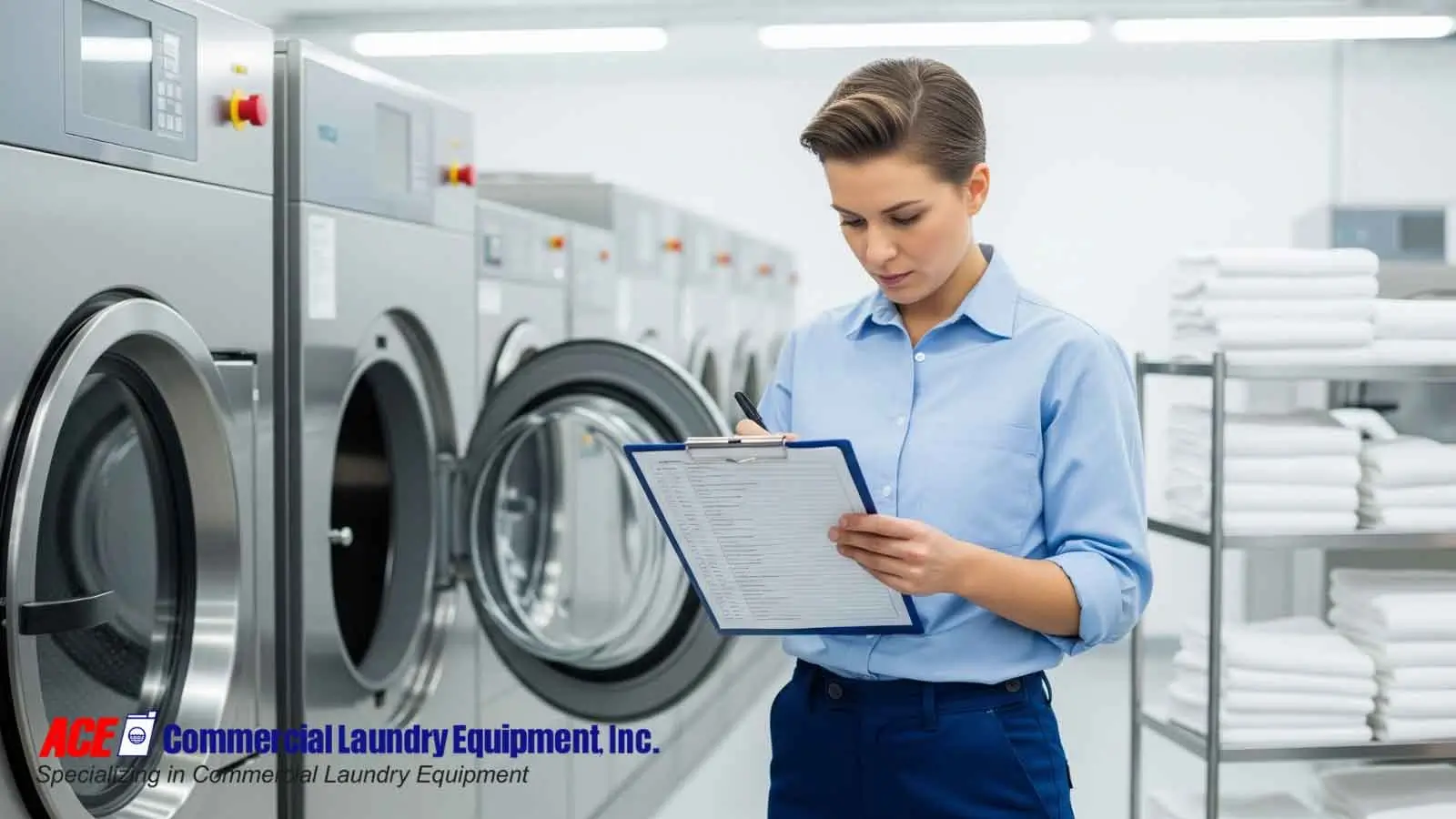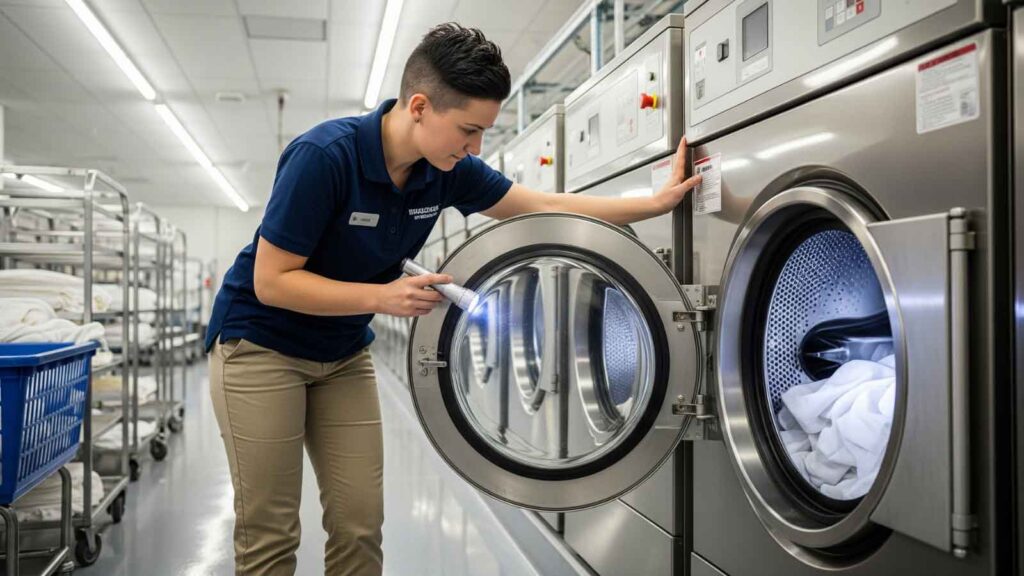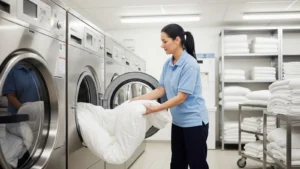Starting a commercial laundry business takes more than simply buying a commercial washer and opening your doors. Success depends on careful planning, smart decisions, and establishing systems that keep everything running smoothly from the start.
This checklist will guide you through each step, from laying the groundwork to preparing your space, in a clear, practical manner that’s easy to follow, even if you’re new to the industry.
Laying the Foundation for a New Commercial Laundry Business
Before you can serve your first customer, you need to build a strong foundation for your laundry business. This stage ensures you’re legally, financially, and operationally ready to open your doors with confidence.
- Market Research: Every laundry business serves a unique community, so it’s essential to understand local demand before choosing where to open. Research your competitors, what services they offer, and what gaps might exist in your area. You can also talk to potential customers to learn about their laundry habits and preferences. These insights help you position your business in a way that meets real needs rather than relying on guesswork.
- Business Plan: A business plan serves as a roadmap, guiding you from the idea stage to a fully operational laundry. It should outline startup costs, such as equipment and space preparation, as well as recurring expenses like utilities and staffing. Adding realistic income projections provides a means to measure progress against expectations. A well-built plan also makes it easier to secure financing, whether through loans or investors.
- Legal Requirements: Setting up legally from the start protects you from future headaches. This means registering your business under the proper structure, securing the required local or state permits, and getting insurance that covers both property and liability. Failing to address these issues early can result in costly delays or even fines. Once these are in place, you’ll know your business has a secure foundation.
- Finances and Staffing: Think ahead about whether you’ll hire employees right away or manage most tasks yourself. If you hire, decide which roles you need first, such as attendants, cleaners, or maintenance support. You should also set up simple accounting tools or software to track income and expenses from the start. Having organized finances helps you make more informed decisions about costs and future growth.
Location and Space Preparation
Once your foundation is in place, the next step is to find the correct physical location and prepare it for daily operations. The space you choose will shape customer experience and determine how efficiently your business runs.
- Choosing the Right Spot: Your business location will have a significant impact on the number of customers who walk through the door. Look for places with strong street visibility, easy parking, and convenient public transportation access. The more convenient it is for people to reach you, the more likely they are to return regularly. Choosing wisely here can make your business appear approachable and reliable from the outset.
- Preparing the Space: A laundry facility needs more than an empty building. The flooring must support heavy machines, the ventilation should be strong enough to handle moisture and heat, and the layout should keep customer areas separate from working zones. This ensures both safety and efficiency. Preparing the space properly also means fewer repairs and smoother daily operations once you open.
- Utility Setup: Commercial machines use much more water, power, and drainage than home washers. Make sure your space has plumbing that can handle high-volume water flow and drainage systems that won’t clog or back up under heavy use. Electrical wiring also needs to meet the demands of multiple high-capacity machines. Getting these systems right from the start prevents interruptions and costly fixes later.
- Safety and Accessibility: Customer trust comes from feeling safe and comfortable in your facility. This means adding clear fire exits, bright lighting both inside and outside, and ramps or accessible features that comply with ADA guidelines. Small details, such as wide aisles and visible signage, also make the space more welcoming. Building accessibility into your setup expands your customer base and avoids compliance issues down the line.
Read Also: The Importance of Regular Cleaning for Commercial Laundry Machines
The Core Equipment and Amenities Checklist
This section is the backbone of your setup, since the right equipment and amenities decide how smoothly your laundry runs and how satisfied your customers feel. By focusing on essentials, comfort, and safety, you can establish a reliable operation from the outset.
Essential Laundry Equipment
Every commercial laundry depends on durable, reliable machines that can handle frequent, heavy use. Beyond just washers and dryers, payment systems also shape how easy it is for customers to do business with you.
- Washers and Dryers: Choose energy-efficient, heavy-duty machines designed for constant use. Residential units won’t withstand the demand of dozens of loads per day, so commercial models are a must. Consider machines with high-speed extraction to reduce drying time, which also saves energy. Investing in quality commercial laundry equipment now prevents expensive breakdowns and downtime later.
- Payment Systems: Modern customers expect convenience, so offering flexible payment options makes a big difference. Coin-operated systems are traditional, but many people prefer card-based or mobile app solutions. A hybrid system enables you to cater to both preferences without alienating anyone. Reliable payment options also reduce staff oversight, since customers can handle transactions independently.
Customer Comfort and Convenience
Your business isn’t just about cleaning clothes; it’s also about creating a space customers want to return to. Small touches that make the process easier and more pleasant help build loyalty.
- Detergent and Supply Vending: Many people forget laundry detergent or softener, so having vending machines stocked with these essentials solves the problem. Offering additional small laundry supplies, such as dryer sheets or stain removers, adds extra convenience. This keeps customers from leaving mid-wash and builds trust in your business as a one-stop shop. It’s a simple addition that can also bring in extra revenue.
- Folding Stations and Carts: Customers require space to manage their clean laundry, so sturdy folding tables and rolling carts are essential. Tables should be wide enough for bedding or larger items, while carts make moving loads easier. Providing these tools reduces customer frustration and prevents clothes from ending up on the floor. Comfortable seating nearby also encourages repeat visits, especially for those waiting on long cycles.
- Cleanliness and Comfort: A clean, well-lit laundry space creates a positive first impression and reassures customers about the hygiene standards. Regularly sweeping floors, wiping down machines, and emptying trash bins helps maintain a professional look. Bright lighting and good ventilation also make the environment more comfortable. The more pleasant your facility feels, the more likely customers are to come back consistently.
Security and Monitoring
Protecting your investment and ensuring customer safety are just as important as having the right machines. A secure environment prevents issues and demonstrates to customers that they can trust your business.
- Surveillance: Security cameras act as both a deterrent and a safety measure for customers. Placing them near entrances, exits, and machine areas gives you coverage of high-traffic zones. Combined with intense outdoor lighting, cameras reduce theft and vandalism risks. A secure setup provides peace of mind to both owners and customers.
- Maintenance Logs: Every machine in your facility needs regular care to run reliably. Keeping logs for each washer and dryer helps you track servicing dates, repairs, and the performance of each unit. These records prevent minor issues from turning into costly breakdowns. A well-documented maintenance system also facilitates the identification of patterns and planning for future upgrades.
Running and Maintaining Operations
Even with the proper setup, your laundry business only succeeds if it runs smoothly day after day. Establishing consistent routines helps you avoid costly mistakes, maintain equipment, and keep customers happy.
- Standard Operating Procedures (SOPs): Writing down transparent, step-by-step processes ensures consistency, whether you’re running the shop yourself or training staff. SOPs should cover everything from opening and closing routines to machine cleaning and handling customer issues. Having these written guidelines in place reduces confusion and helps new staff members learn more quickly. Over time, SOPs also make it easier to maintain a professional and dependable service.
- Maintenance Routine: Scheduling regular inspections keeps washers and dryers working at their best. A simple checklist, such as cleaning lint filters daily and inspecting hoses weekly, prevents problems from accumulating. Regular professional servicing every few months can also help extend the lifespan of your machines. Reliable maintenance is especially crucial for a commercial dryer, as heat buildup from neglect can quickly lead to costly repairs.
- Inventory Management: Running out of detergent or vending machine stock can frustrate customers and cause them to seek alternatives elsewhere. Keep track of which items sell quickly, such as detergent packs or dryer sheets, and reorder them before supplies run out. It’s also smart to keep spare parts, such as hoses or belts, on hand, so minor fixes don’t cause prolonged downtime. A solid inventory routine ensures your business always runs smoothly.
- Customer Service and Marketing: Beyond clean machines, people come back for the way they’re treated. Train staff to greet customers, handle questions politely, and solve problems quickly. Promote your business locally with flyers, social media posts, or a well-optimized Google Business Profile listing. Consistent, positive customer service paired with clever marketing builds loyalty and attracts new visitors.
Start Strong and Scale Up
Launching your laundry business is just the first step; success comes from building a steady foundation before considering growth. Focus on running operations smoothly for the first few months to learn what works best for your location.
Once you’ve mastered the basics, you can expand your services with extras like pickup and delivery, wash-and-fold packages, or loyalty programs that reward frequent customers. These add-ons not only generate new revenue but also help your business stand out in a competitive market. Growing step by step ensures you don’t stretch resources too thin, while still giving customers more reasons to choose your service.
Launch Your Commercial Laundry Business with Confidence
You don’t have to go it alone. Ace Laundry offers the full support new operations need to hit the ground running. We supply high-performance machines and parts through our Commercial Laundry Equipment offerings, ensuring your setup is built to last. Our Laundry Room Management services help you maintain uptime, with servicing, parts replacement, and remote support, so breakdowns never sideline you.
Additionally, you can source everything from detergents to coin boxes through our Supply division, which ensures essential items are stocked and ready.
Contact us to talk about how we can partner with you, from your first machine purchase to seamless daily operations, so you can focus on growing, not troubleshooting.





